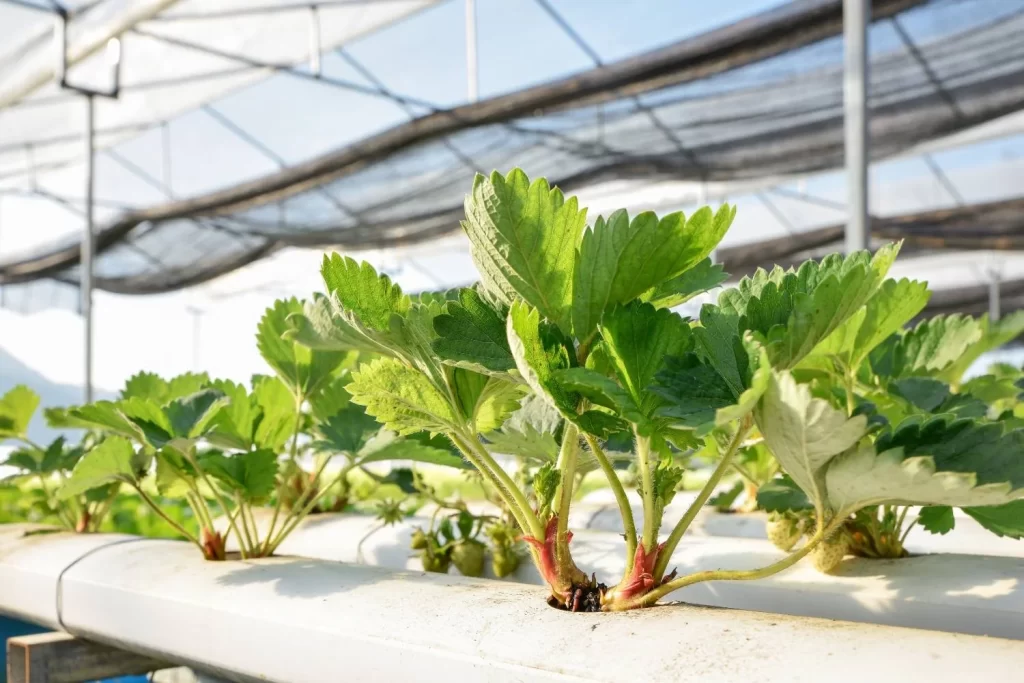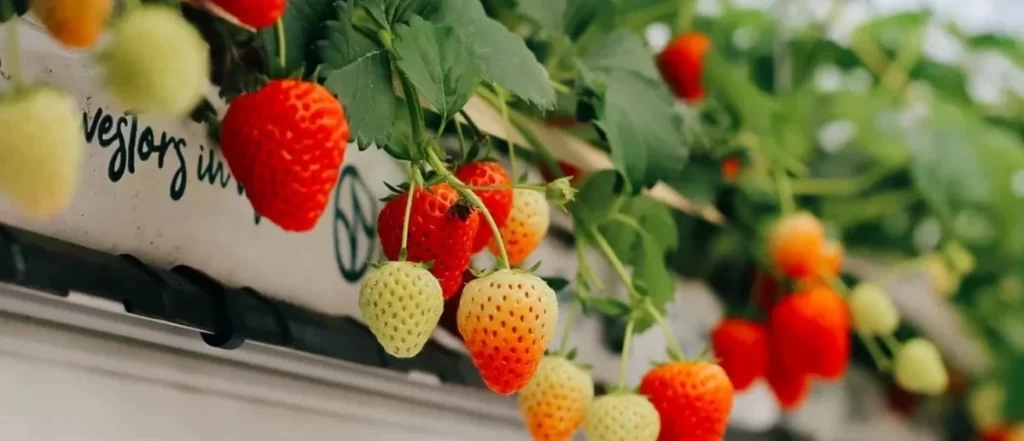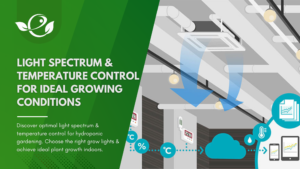Table of Contents
Growing hydroponic strawberries is a modern, efficient, and surprisingly simple way to cultivate this delicious fruit at home. While hydroponics might sound like a complex method meant for advanced gardeners, it’s actually beginner-friendly and incredibly rewarding!
Whether you’re intrigued by the idea of growing strawberries year-round, fascinated by the tech-savvy approach of soil-free farming, or just looking for a clean and space-efficient gardening method, hydroponics has something to offer. With a bit of guidance and the right setup, you’ll be harvesting sweet, juicy strawberries in no time.
In this guide, we’ll take you through everything you need to know—from understanding the basics of hydroponic systems to planting, maintaining, and troubleshooting your strawberry garden. So, grab your gardening gloves (or maybe just your enthusiasm), and let’s get started!
Why Grow Strawberries in a Hydroponic System?
Advantages
- Faster Growth Cycles: Hydroponic systems deliver nutrients directly to the roots, speeding up growth.
- Higher Yields: Controlled environments maximize productivity per square foot.
- Water Efficiency: Uses up to 90% less water than soil farming.
- Pest Resistance: Reduces exposure to soil-borne pests and diseases.
- Space-Saving: Vertical and compact systems make hydroponics perfect for limited spaces.
Disadvantages
- High Initial Costs:
- Setting up a hydroponic system can be expensive, especially for advanced systems like aeroponics.
- Equipment such as grow lights, pumps, and nutrient reservoirs add to the initial investment.
- Technical Expertise Required:
- Hydroponic systems require knowledge of nutrient management, pH levels, and system maintenance.
- Beginners may face a steep learning curve.
- Power Dependency: Most hydroponic systems rely on electricity to operate pumps and lights, making them vulnerable to power outages.
- Regular Maintenance:
- Systems need frequent monitoring to prevent clogs, leaks, or nutrient imbalances.
- Algae buildup and waterborne diseases can become issues if not addressed promptly.
- Limited Crop Variety: While strawberries thrive in hydroponic systems, not all plants adapt as well, limiting diversity.
- Environmental Control Challenges: Maintaining optimal temperature, humidity, and light conditions can be challenging and energy-intensive, especially in extreme climates.
Choosing the Right Hydroponic System
Selecting the right system depends on your experience, space, and goals. Here are popular options:
- Nutrient Film Technique (NFT): Ideal for small spaces and beginners. In this system, the nutrient solution flows continuously along the roots. This system requires a proper slope and consistent water flow.
- Deep Water Culture (DWC): Plants are suspended in the oxygenated nutrient solution. This system is Simple and cost-effective for beginners. Regular monitoring of water quality is crucial in this system.
- Ebb and Flow: Periodic flooding and draining provide nutrients and oxygen. This system is suitable for moderate experience levels and best for medium to large setups.
- Drip Systems: Nutrients drip directly to each plant’s roots. Highly efficient for commercial growers.
- Aeroponics: In this system roots are misted with nutrient solutions. This advanced system offering maximum oxygenation, requires expertise and consistent monitoring.
Recommendations:
- Beginners: Start with NFT or DWC systems for ease of use.
- Advanced Growers: Experiment with aeroponics for higher yields.
Guide to Setting Up a Hydroponic Strawberry System
Growing hydroponic strawberries requires careful planning and execution. Below is a detailed guide to help you set up your system for success.
1. Selecting Strawberry Varieties
- Day-Neutral Varieties: Recommended for hydroponics due to continuous fruiting. Examples include:
- Albion
- Seascape
- Eversweet
- These varieties adapt well to hydroponic environments and produce consistent yields throughout the year.



2. Preparing the Growing Area
- Space Requirements: Choose a location with sufficient space for your hydroponic system. Ensure easy access for maintenance.
- Lighting Setup: Install LED grow lights if natural light is insufficient. Position lights 12–16 inches above the plants.
- Ventilation: Set up fans or ventilation systems to maintain airflow and prevent fungal issues.
3. Assembling Your Hydroponic System
- Choose the System Type: Based on your expertise and space, select from NFT, DWC, or other systems.
- Gather Materials:
- Nutrient reservoir
- Water pump
- Net Pots
- Air pump and stones (for aeration)
- Grow lights
- Timer
- pH and EC meters
- Hydroponic Nutrients
- Install the System: Follow manufacturer instructions for setup. Ensure proper drainage and circulation.
4. Preparing the Nutrient Solution
- Use a high-quality hydroponic fertilizer with essential macro- and micronutrients.
- Mix the solution in the reservoir, maintaining a pH between 5.5–6.5 and an EC level of 1.4–2.0 mS/cm.
- Regularly monitor and adjust the solution to ensure optimal plant health.
5. Planting Strawberries
Before you begin, you need to choose whether to grow strawberries from seed or to use young plants. Growing from seed can take years before your plants bear fruit, making it a slower option. A quicker alternative is to find young strawberry plants and transplant them into your hydroponic system using a medium of your choice and net pots. To do this, fill the net pots partially, rinse the soil off the roots of the plant, place it in the pot, and fill the pot the rest of the way to secure the plant. Make sure to water it well right after planting.
- Using Runners: Select healthy runners from existing plants. Soak the roots in water before planting.
- From Seeds: Although slower, growing from seeds allows for more variety.
- Spacing: Maintain 8–12 inches between plants to ensure adequate airflow and light penetration.


Best Growing Medium for hydroponic strawberries
The best growing medium for hydroponic strawberries depends on the system you use and the requirements of the plants, as strawberries thrive in a well-aerated, moisture-retaining, and nutrient-supportive medium. Coco coir is an excellent choice for many growers because it retains moisture well while allowing for good aeration, which helps prevent root rot.
Rockwool is another popular option, especially in commercial setups, as it provides a sterile, pH-neutral environment and excellent water retention. Perlite and vermiculite can be used in combination or mixed with other substrates to improve drainage and aeration.
Expanded clay pellets, also known as LECA (Lightweight Expanded Clay Aggregate), are favored in systems like Deep Water Culture (DWC) and Nutrient Film Technique (NFT) for their durability, reusability, and efficient drainage. Some growers also use a mix of substrates, such as coco coir with perlite, to balance water retention and aeration. The choice of medium should align with the type of hydroponic system you use and the specific needs of your strawberry plants.
Managing Nutrients and pH for Hydroponic Strawberries
Hydroponic strawberries thrive when provided with precise nutrient levels and pH balance. Proper management of these factors is crucial for ensuring healthy plant growth and maximum yield. Below is an in-depth look at how to effectively manage nutrients and pH in your hydroponic system.
Nutrient Solution Preparation
- Choosing the Right Fertilizer: Look for hydroponic fertilizers with ratios tailored to fruiting plants, such as a 10-5-20 (NPK) blend, ensuring additional trace elements are included.
- Mixing the Solution:
- Follow the manufacturer’s instructions for the correct fertilizer-to-water ratio.
- Use filtered or distilled water to avoid introducing unwanted salts or contaminants.
- Maintaining the Nutrient Reservoir:
- Keep the reservoir clean to prevent algae buildup or contamination.
- Replace the nutrient solution every 7–14 days to ensure freshness and efficacy.
Monitoring pH Levels
The pH of the nutrient solution directly affects nutrient availability to the plants. Hydroponic strawberries prefer a slightly acidic environment:
- Optimal pH Range: 5.5 to 6.5.
- Below this range: Certain nutrients, such as calcium and magnesium, become less available.
- Above this range: Micronutrients like iron may become deficient.
- Regularly test the pH using a digital pH meter or pH test strips. Adjust the pH as needed:
- To Lower pH: Add a small amount of phosphoric acid or citric acid.
- To Raise pH: Use potassium hydroxide or a pH-up solution.
Maintaining Electrical Conductivity (EC)
Electrical Conductivity (EC) measures the concentration of dissolved salts (nutrients) in the water. Hydroponic strawberries require specific EC levels for optimal growth:
- Optimal EC Range: 1.4 to 2.0 mS/cm (millisiemens per centimeter).
- Lower EC: Indicates nutrient deficiency.
- Higher EC: Risks nutrient burn and salt buildup.
- Test the EC weekly and adjust by diluting the solution with water or adding more nutrients.
Environmental Requirements for Hydroponic Strawberries
Creating an optimal environment is critical for the success of hydroponic strawberries. A controlled environment ensures healthy growth, maximizes yields, and prevents common issues such as disease or nutrient deficiencies. Below is a detailed exploration of the key environmental factors and how to manage them effectively.
1. Light Requirements
- Daily Light Duration: Hydroponic strawberries need 12–16 hours of light per day to thrive.
- Type of Light:
- Natural Light: If using outdoor systems, ensure the plants receive full sunlight.
- Artificial Light: For indoor systems, use LED grow lights that emit light in the blue and red spectrums. These lights are energy-efficient and can be tailored to plant needs.
- Light Intensity:
- Aim for a Photosynthetic Photon Flux Density (PPFD) of 200–400 µmol/m²/s for vegetative growth.
- Increase intensity to 400–700 µmol/m²/s during fruiting stages.
2. Temperature Control
- Optimal Range: Maintain air temperatures between 65–75°F during the day.
- Nighttime temperatures should not drop below 55°F, as this can slow plant growth.
- Effects of Temperature Extremes:
- High Temperatures: Can lead to reduced fruit quality, deformed berries, and lower yields.
- Low Temperatures: May delay flowering and slow down overall growth.
- Tips for Regulation:
- Use heaters or insulation during colder months.
- Install ventilation fans or air conditioning for hot climates.
3. Humidity Levels
- Ideal Humidity Range: 50–70% relative humidity (RH) during growth and fruiting stages.
- Issues from Humidity Extremes:
- Low Humidity: Can cause dehydration, leading to wilting and nutrient uptake issues.
- High Humidity: Encourages fungal diseases like powdery mildew and botrytis (gray mold).
- Management Strategies:
- Use a humidifier to increase humidity in dry climates.
- Install a dehumidifier or improve airflow to reduce excess humidity.
4. Ventilation and Air Circulation
- Promotes oxygen exchange, which is essential for healthy root development.
- Reduces the likelihood of fungal diseases by minimizing moisture on leaves.
- Install oscillating fans to keep air moving.
- Position ventilation systems to create a balance of fresh air intake and exhaust.
5. Water Quality and Temperature
- Water Temperature: Maintain between 65–75°F (18–24°C).
- Too cold: Can shock plant roots and slow growth.
- Too warm: Encourages algae and pathogens, reducing oxygen availability.
- Water Quality:
- Use filtered or distilled water to avoid chlorine, salts, and impurities.
- Regularly test for pH and total dissolved solids (TDS).
6. Carbon Dioxide (CO₂) Levels
- Optimal CO₂ Levels: Maintain levels around 1000–1200 ppm during the daylight hours.
- Use CO₂ generators or tanks in controlled environments.
- Ensure proper ventilation to prevent CO₂ buildup, which can be harmful.
Care and Maintenance of Hydroponic Strawberries
Proper care and maintenance are essential for ensuring the long-term health and productivity of hydroponic strawberries. Unlike traditional soil-based farming, hydroponic systems require meticulous attention to system components, environmental conditions, and plant health. Below is a detailed guide to help you maintain your hydroponic strawberry plants effectively.

1. Cleaning and Sterilization
- Clean all components, including nutrient reservoirs, pumps, and tubing, at least once a month.
- Use a mild bleach solution or hydrogen peroxide for sterilization to kill pathogens without harming plants.
2. Regular Inspection of Plants
- Look for signs of nutrient deficiencies such as yellowing leaves (chlorosis) or purple discoloration (phosphorus deficiency).
- Remove any yellow, damaged, or diseased leaves promptly.
- Healthy roots are white or light beige. Dark or slimy roots indicate root rot or fungal issues.
- Rinse roots with clean water if contamination is detected.
- Monitor for discoloration, deformities, or soft spots that could indicate pests or diseases.
3. Pruning and Training
- Prune Dead Leaves: Remove dead or yellowing leaves to redirect energy to healthy growth.
- Train Runners: Trim excessive runners (horizontal shoots) to concentrate resources on fruiting.
- Thinning: For high-density systems, thin out crowded plants to improve light penetration and airflow.
Common Challenges and How to Overcome Them
Hydroponic systems, while innovative and efficient, present unique challenges that require proactive management. Understanding these common issues and their solutions can ensure your hydroponic setup operates optimally and yields healthy crops. Below is an in-depth look at these challenges and practical ways to address them:
1. Nutrient Imbalances
- Causes:
- Incorrect mixing ratios of nutrients.
- pH fluctuations affecting nutrient availability.
- Inconsistent monitoring of nutrient levels.
- Solutions:
- Regularly test and adjust the nutrient solution’s EC (Electrical Conductivity) and TDS (Total Dissolved Solids) to ensure balanced concentration levels.
- Maintain pH levels between 5.5 and 6.5 for optimal nutrient uptake.
- Use high-quality, hydroponic-specific nutrient mixes that include all essential macro and micronutrients.
2. pH Instability
- Causes:
- Poor-quality water containing high mineral content.
- Overuse of certain acidic or basic nutrient solutions.
- Solutions:
- Test the pH daily using a calibrated pH meter and adjust with pH stabilizers (pH Up or pH Down).
- Use reverse osmosis (RO) water or distilled water to minimize mineral interference.
- Regularly flush the system to remove residual salts that may cause fluctuations.
3. Root Diseases and Rot
Since hydroponic systems rely on water as the growing medium, they are susceptible to waterborne pathogens like Pythium (root rot) and other fungal infections.
- Causes:
- Stagnant water or insufficient oxygenation.
- High temperatures promoting pathogen growth.
- Solutions:
- Ensure proper aeration by using air stones and pumps to oxygenate the water.
- Maintain water temperatures between 65–75°F (18–24°C) to inhibit fungal growth.
- Use beneficial microbes or hydroponic-friendly fungicides to combat harmful pathogens.
- Avoid overcrowding plants to improve airflow and reduce humidity around the root zone.
4. Algae Growth
- Causes:
- Light exposure on nutrient solution or moist areas.
- High humidity levels.
- Solutions:
- Cover all reservoirs, pipes, and containers with opaque materials to block light.
- Clean the system regularly with a mild sterilizing agent.
- Add algaecides approved for hydroponic systems if the problem persists.
5. Pest Infestations
- Common Pests: Aphids, spider mites, whiteflies, and thrips are the most prevalent pests in hydroponics.
- Solutions:
- Introduce beneficial insects, such as ladybugs or predatory mites, to naturally control pest populations.
- Use organic pest repellents or insecticidal soaps that are safe for hydroponic use.
- Monitor plants regularly for signs of infestation and isolate affected plants immediately.
6. Equipment Failures
- Causes:
- Power outages or equipment wear and tear.
- Improper installation or maintenance.
- Solutions:
- Perform routine checks on all equipment to ensure they function correctly.
- Invest in backup systems, such as battery backups for pumps and timers or generators for lighting systems.
- Keep spare parts, such as replacement pumps or tubing, readily available.
7. Water Quality Issues
- Causes:
- High mineral content (hard water).
- Contaminants like chlorine or chloramines.
- Solutions:
- Use RO or distilled water to ensure purity.
- Install water filters to remove impurities from the supply.
- Test water regularly for pH, EC, and presence of harmful substances.
8. Temperature and Humidity Management
- Challenges:
- High temperatures can cause heat stress and reduce oxygen levels in the water.
- Low humidity can lead to dehydration, while excessive humidity can foster mold and mildew.
- Solutions:
- Use heaters or cooling systems to maintain air temperatures between 65–75°F.
- Install dehumidifiers or humidifiers to regulate humidity levels within the optimal range of 50–70%.
- Provide adequate ventilation to ensure consistent airflow around plants.
9. Plant Overcrowding
- Causes: Planting too many crops in a limited space.
- Solutions:
- Follow proper spacing guidelines for each plant variety.
- Prune plants regularly to improve airflow and light penetration.
10. Knowledge Gaps
- Causes: Inadequate research or experience.
- Solutions:
- Educate yourself with online courses, books, and tutorials on hydroponic farming.
- Join hydroponic communities or forums to exchange knowledge and seek advice.
- Start with a smaller system to gain hands-on experience before scaling up.
By addressing these challenges with a proactive and informed approach, hydroponic growers can create a resilient and productive system. The key lies in constant monitoring, timely intervention, and a commitment to learning and adapting as needed.
Harvesting Hydroponic Strawberries
Harvesting hydroponic strawberries requires careful timing and techniques to maximize yield quality and maintain plant health for future growth. Since hydroponically grown strawberries often mature faster and more uniformly than soil-grown varieties, understanding when and how to harvest is crucial.

1. Right Time to Harvest
The optimal time to harvest strawberries is when they are fully ripened. Unlike some fruits, strawberries do not continue to ripen after being picked.
Appearance
- The berries should have a uniform, vibrant red color from tip to stem.
- Check for a glossy sheen, which indicates peak ripeness.
Texture
- Fully ripe strawberries feel firm but slightly tender when gently squeezed.
- Avoid harvesting if the fruit feels overly soft or mushy, as it may be overripe.
Taste and Aroma
- Ripe strawberries emit a sweet, fruity aroma.
- You may taste-test a sample berry to confirm its sweetness and flavor.
Hydroponic strawberries typically ripen within 28–30 days after flowering, although this timeline can vary slightly based on the cultivar and growing conditions.
2. Harvesting Technique
Proper handling during harvesting is essential to prevent damage to the delicate fruit and the plant.
- Use sterilized scissors or pruning shears to cut the stem just above the berry cap (calyx). This reduces the risk of bruising or tearing the fruit.
- Avoid pulling or twisting the berry off the stem, as this can damage the plant and reduce its productivity.
- Place harvested berries into shallow containers to prevent bruising or crushing.
- Avoid stacking berries too high, as their delicate skin is prone to damage under weight.
3. Harvesting Frequency
Hydroponic strawberries are often ready for harvest every 2–3 days during the peak fruiting season.
- Picking ripe fruit promptly encourages the plant to produce more flowers and fruit.
- Leaving overripe fruit on the plant can attract pests or lead to fungal growth.
4. Post-Harvest Handling
Proper handling and storage after harvest are critical to maintaining the quality and shelf life of hydroponic strawberries.
- Sorting and Cleaning:
- Discard any damaged or diseased fruit to prevent spoilage from spreading.
- Do not wash the strawberries until just before consumption, as moisture can hasten spoilage.
- Storage:
- Store berries in a cool, dry place or refrigerate them at temperatures between 32–40°F (0–4°C) to extend shelf life.
- Use breathable containers or line them with paper towels to absorb excess moisture.
Conclusion
Hydroponic strawberries offer a sustainable and efficient way to enjoy fresh fruit year-round. With the right system, proper care, and some practice, you can achieve impressive results. Start small, monitor your progress, and enjoy the fruits of your labor—literally!
Ready to start your hydroponic journey? Share your experiences or questions in the comments below!
FAQs About Hydroponic Strawberries
Are hydroponic strawberries better?
Hydroponic strawberries can be considered better in some ways—they grow faster, use less water, and are not affected by soil-borne pests or diseases. However, their flavor may vary depending on how well nutrients and environmental factors are managed.
How long do strawberries take to grow hydroponically?
Strawberries typically take about 60–90 days from planting to harvest in a hydroponic system, depending on the variety and growing conditions.
Are hydroponic strawberries cleaner?
Yes, hydroponic strawberries are cleaner since they are grown without soil, reducing the risk of dirt and soil-borne contaminants.
How are hydroponic strawberries made?
Hydroponic strawberries are grown using a nutrient-rich water solution in place of soil. The plants are supported in a hydroponic system like NFT, DWC, or drip systems, where their roots absorb nutrients directly from the water while environmental factors such as light, temperature, and humidity are carefully controlled.
Can I grow strawberries indoors year-round?
Yes, with proper lighting and temperature control.
What is the cost of a hydroponic setup?
Costs vary but start at $100 for basic DIY systems.








